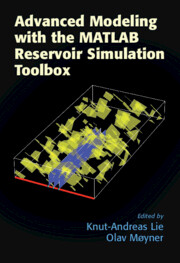Book contents
- Frontmatter
- Contents
- List of Contributors
- Preface
- Acknowledgments
- Navigating the Book and the MRST Modules
- Part I Grid Generation, Discretizations, and Solvers
- 1 Unstructured PEBI Grids Conforming to Lower-Dimensional Objects
- 2 Nonlinear Finite-Volume Methods for the Flow Equation in Porous Media
- 3 Implicit Discontinuous Galerkin Methods for Transport Equations in Porous Media
- 4 Multiscale Pressure Solvers for Stratigraphic and Polytopal Grids
- Part II Rapid Prototyping and Accelerated Computation
- Part III Modeling of New Physical Processes
1 - Unstructured PEBI Grids Conforming to Lower-Dimensional Objects
from Part I - Grid Generation, Discretizations, and Solvers
Published online by Cambridge University Press: 20 November 2021
- Frontmatter
- Contents
- List of Contributors
- Preface
- Acknowledgments
- Navigating the Book and the MRST Modules
- Part I Grid Generation, Discretizations, and Solvers
- 1 Unstructured PEBI Grids Conforming to Lower-Dimensional Objects
- 2 Nonlinear Finite-Volume Methods for the Flow Equation in Porous Media
- 3 Implicit Discontinuous Galerkin Methods for Transport Equations in Porous Media
- 4 Multiscale Pressure Solvers for Stratigraphic and Polytopal Grids
- Part II Rapid Prototyping and Accelerated Computation
- Part III Modeling of New Physical Processes
Summary
The upr module in the MATLAB Reservoir Simulation Toolbox (MRST) can construct unstructured Voronoi grids that conform to polygonal boundaries and geometric constraints in arbitrarydimensions prescribed inside the reservoir volume. The resulting volumetric tessellations are usually realized as locally orthogonal, perpendicular bisector (PEBI) grids, in which cell faces can be aligned to accurately preserve objects of codimension one (curves in 2D and surfaces in 3D) and/or cell centroids can be set to follow curves in 2D or 3D. This enables you to accurately model faults, let grid cells follow horizontal and multilateral well paths, or create lower-dimensional or volumetric representations of fracture networks. The module offers methods for improving grid quality, like configurable policies for treating intersecting geometric object and handling conflicts among constraints, methods for locating and removing conflicting generating points, as well as force-based and energy-minimization approaches for optimizing the grid cells. You can use \mcode{upr} to create a consistent hierarchy of grids that represent the reservoir volume, the constraining geometric objects (surfaces and curves), as well as their intersections. The hierarchy is built such that the cell faces of a given (sub)grid conform to the cells of all bounding subgrids of one dimension lower.
Keywords
- Type
- Chapter
- Information
- Publisher: Cambridge University PressPrint publication year: 2021
- Creative Commons
- This content is Open Access and distributed under the terms of the Creative Commons Attribution licence CC-BY-NC-ND 4.0 https://creativecommons.org/cclicenses/
- 2
- Cited by

